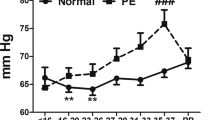Summary
Penbutolol is a not cardioselective beta-adrenergic blocking drug; it is lipid soluble and differs in its protein binding from the other members of its group because shows linkage to alpha1-glycoprotein, with no detectable binding to albumin. A A G levels change during pregnancy and so the binding of [3H]-penbutolol was compared in 11 pregnant patients and in 10 healthy women. Binding was obtained by ultrafiltration and measurement of the free fraction by scintillation spectrometry. The free penbutolol fraction was significantly higher in the pregnant women than in the controls ( 6.06±0.34 compared with 3.55±0.29, P< 0.001).The AAG levels in the pregnant women were significantly lower (0.40±0.03g/1) than in the controls (0.77±0.06 g/l) (P<0.001) which showed a significant correlation with the bound/free penbutolol ratio (r = 0.61, P<0.005). On the other hand there was no significant correlation with the extent of penbutolol’s protein binding even though the albumin levels were lower in the pregnant women (2.83±0.17 compared with 4.86±0.17; P<0.001). Penbutolol’s nK1a for AAG was lower in pregnant women, and this suggests that the fall in AAG levels is not the only factor involved in the reduced binding of penbutolol in pregnancy.
Similar content being viewed by others
References
Nyberg G., Wilhelmsson C., Vedin A. (1979): Intrinsic sympathomimetic activity of Penbutolol. Eur. J. Clin. Pharmacol. 16, 381–386.
Heel R.C., Brogden R.N., Speight T.M., Avery G.S. (1981): Penbutolol: A preliminary review of its pharmacological properties and therapeutic efficacy in hypertension and angina pectoris. Drugs 22, 1–25.
Jun H.W., Hayes S.L., Vallner J.J., Honigberg L., Rojos A. E., Stewart J.T.J. (1979): Plasma level profiles and clinical response of Penbutolol after three different single oral doses in man. Clin. Pharmacol. 19, 415–423.
Hajdu P., Damm D. (1979): Physicochemical and analytical studies of Penbutolol. Arzneimittel-Forschung 29, 602–606.
Romer J., Bickel M.H. (1979): A method to estimate binding constants at variable protein concentration. J. Pharm. Pharmacol. 31, 7–11.
Glasson S., Zin R., D’Athis P., Tillement J.P., Boissier J.R. (1980): The distribution of bound propranolol between the different human serum protein. Mol. Pharmacol. 17, 187–191.
McDevitt D. G., Frisk-Holmberg M., Hollifield J.W., Shand D.G. (1976): Plasma binding and the affinity of propranolol for a beta-receptor in man. Clin. Pharmacol. Ther. 20, 152–157.
Wood M., Wood A.J.J. (1981): Changes in plasma drug binding and alphar acid glycoprotein in mother and newborn infant. Clin. Pharmacol. Ther. 29, 522–526.
Author information
Authors and Affiliations
Rights and permissions
About this article
Cite this article
Aquirre, C., Rodriguez-Sasiain, J.M., Navajas, P. et al. Plasma protein binding of penbutolol in pregnancy. European Journal of Drug Metabolism and Pharmacokinetics 13, 23–26 (1988). https://doi.org/10.1007/BF03189924
Received:
Issue Date:
DOI: https://doi.org/10.1007/BF03189924




